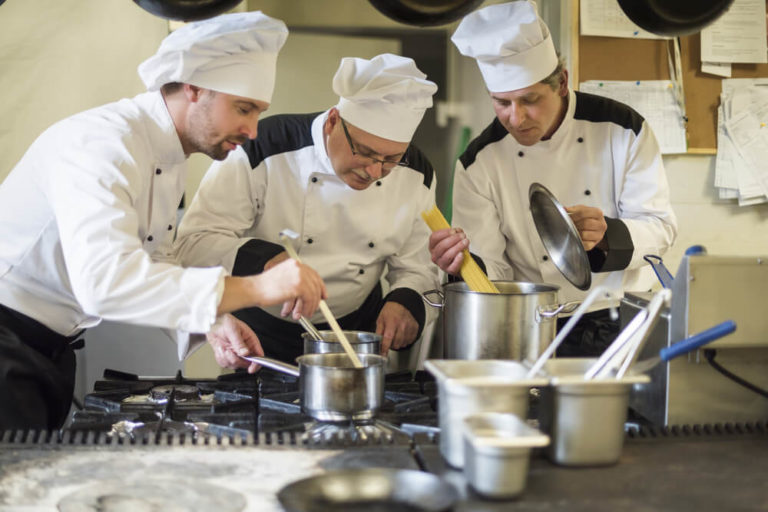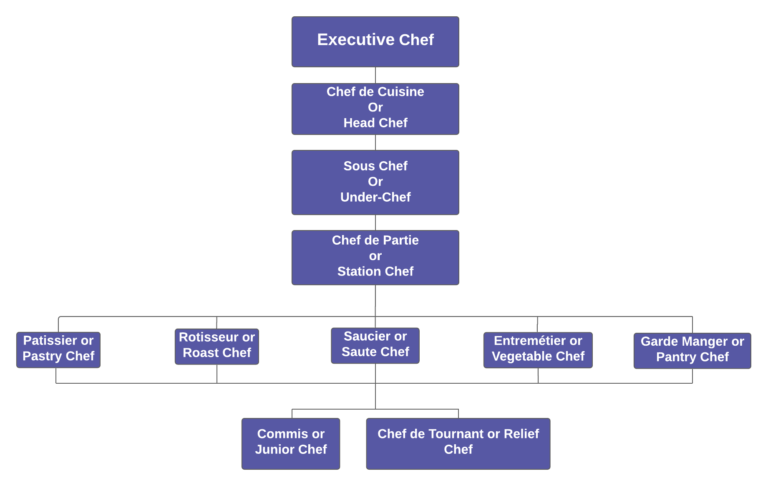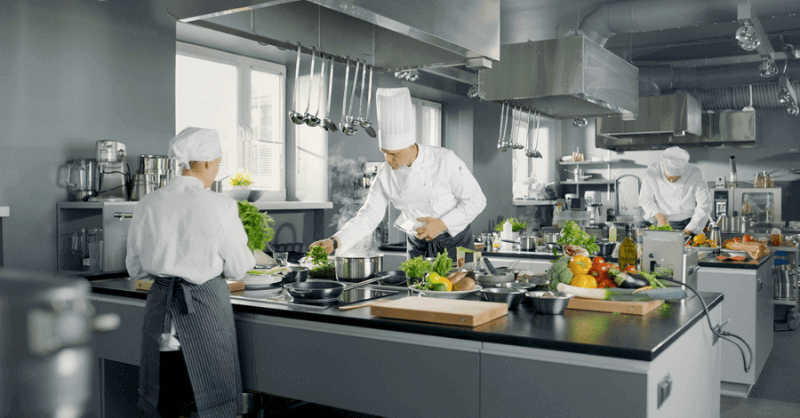Chef hierarchy or kitchen hierarchy can be quite confusing if you’re not familiar with the restaurant or hospitality industry.
Chefs are what makes a restaurant what it is. Chefs are responsible for everything in a restaurant, like managing kitchens, creating recipes, processing the foods and dealing with the pantry. They also keep the inventory in check and ultimately putting their best into the plates that go in front of the guest.
Working in a restaurant as a chef can be as exciting and fast-paced as any other business. And chefs of different levels work in unison in the kitchen to deliver the best food with flawless presentation. Like any other job, professional chefs have a hierarchy too, from beginner to executive. For example, there are managerial chefs, specialised chefs, and they have different titles according to their experience and expertise.
The ranking and titles vary from restaurant to restaurant; if the restaurant is small, it is not necessary there be a chef for every position. The larger the kitchen, the more ranking and titles there is, to establish order and a smooth cooking process.
If you have a keen interest in learning how a restaurant functions, or to learn the career path of a chef, you need to know how the rank work in a formal kitchen. Follow us below, and you will know a lot about chef hierarchy and different chef titles.
Brigade de Cuisine - Chef Hierarchy

Brigade de Cuisine is a system followed by the restaurant to establish a chef hierarchy in the kitchen. This system is also known as the kitchen brigade. The idea came from Georges Auguste Escoffier with the French Brigade System’s creation in the nineteenth century. The system helps distribute tasks to the different staff working in the kitchen and dining according to their experience.
Many chefs attend culinary school to get complete knowledge and an expert degree in cooking. It helps them develop a better understanding of foods and taste, and some can start from the junior position at a restaurant. But both sorts goes up the hierarchy over time depending on their quality and expertise.
What are the Chef Ranking or Chef Hierarchy?
There are various types of chefs, and some contribute directly to the cooking of food. At the same time, some chefs are responsible for looking after the inventory and processing the food precisely as needed. The chef who takes the highest positions manages the chef working in different sections and looks if it runs efficiently.
Let’s have a detailed look at the main types of kitchen chefs, chef hierarchy and their task, starting from the highest position.

Executive Chef
This is the top rank in a restaurant that follows Brigade de Cuisine or Kitchen hierarchy. There is only one executive chef for a restaurant. Executive chefs are responsible for managing the entire kitchen crew. They keep track of all the kitchen activity, billing, inspect food while processing and delivering it to the guest.
They check if other chefs are doing their job properly, executive chefs design the menu and what kind of recipes should go out on the plate. Furthermore, they are not the owner of the restaurant but hold the highest authority. Executive chefs do not directly contribute to cooking. It takes years and years of practice and experience to reach the level of executive chef.
When there are multiple restaurant chains, they need an executive chef or two to run the restaurant.
Chef de cuisine or Head Chef
Chef de cuisine works directly under the Executive Chef. At some restaurants, the Executive chef is the Chef de cuisine or the highest chef ranking system. But usually, they assist the executive chef in running the restaurant. Chef de cuisine is the traditional French term that means “ kitchen chief” or “kitchen manager”.They oversee everything important that is happening in the restaurant.
Firstly, the head chef is responsible for engineering the menu and recipes, fixing a budget for the groceries, and managing other line chefs and keeping communication between other staff of the restaurant. Secondly, the head chef contacts the suppliers and keep everything organised. They also contribute to training younger chefs sometimes. Finally, they sometimes have their chef’s speciality and signature dishes that are the speciality of the restaurant and also cooks the newest recipes on the menu.
Sous chef or Under Chef
Sous chefs are the third in highest authority in a restaurant. It means “under the chef” They work closely with executives or the head chef and run the kitchen in their absence. Simply told, they are assistant to the head chef, and there can be more than one sous chef in a kitchen, depending on its size. Their main task is team management, and they must have quick decision-making skills. They also do administrative works such as ordering stocks and invoicing and train the junior chefs to cook with consistent quality. They are also in charge of the kitchen and restaurant hygiene.
The sous chef directs the line cooks and the prep cook. When something goes wrong in the kitchen, the sous chef usually takes care of it so that the executive chef doesn’t have to. The sous chef is also in charge of performing all other tasks which the executive chef delegates to keep the restaurant running smoothly. They are the bridge of communication between the front and back of the restaurant.
The Sous Chef Hierarchy:
♦ Head Chef
♦ Sous Chef
♦ Chef de Partie
♦ Commis Chef
Chef de Partie or Station Chef
Chef de Partie or Station chefs are those chefs who have mastered a particular line of production or form of cooking. For example, preparing soup, prep desserts or preparing salads or grills, there is at least one station chef for each task. They are specialists in specific parts of the menu and play a vital role in the kitchen brigade system. There is more than one station chef, depending on the different types of food that is cooked. The station chef is the team leader for the chef working on the same food speciality and reports back to the Sous chef. They prepare foods and instructs other chefs to cook in specific ways.
There are Five primary types of Chef de Partie:
- Patissier or Pastry Chef
- Rotisseur or Roast Chef
- Saucier or Saute Chef
- Entremétier or Vegetable Chef
- Garde Manger or Pantry Chef
Patissier or Pastry Chef
The main task of the pastry chef is to make baked goods and desserts. They make doughs and batters and create cakes and sweets along with the decorations. They organise and are responsible for creating the entire dessert menu of the restaurant. The restaurant that wants to become known for its sweet and baked goods needs a pastry chef course. There is an entire brunch dedicated to Pastry and baking in a culinary school.
In a pastry chef hierarchy, the positions are structured as follows:
– Head Pastry Chef: Leads the pastry kitchen and oversees all pastry operations.
– Pastry Sous Chef: Assists the head pastry chef and manages the kitchen in their absence.
– Pastry Chef de Partie: Leads a specific section within the pastry kitchen, such as cakes or pastries.
– Pastry Commis: Entry-level position responsible for basic tasks and assisting higher-ranking chefs.
Rotisseur or Roast Chef
Roast Chefs are responsible for cooking different types of meats and sauces. They also prepare meats by roasting, braising, broiling, or with another kind of cooking style. Furthermore, they should be expert in dealing with meats and understand the doneness of the flesh. Cooking a different kind of meats needs a different type of time. Hence, they must know how long to cook specific meats and some corresponding dishes. The roast chef also needs preparation skills, keeping time and taste in mind.
There are two chefs that may work under a roast chef, and they are
- Grillardin or Grill Chef: they are responsible for grilling meats and sometimes vegetables
- Friturier or fry chef: This chef is accountable for making all kinds of fried foods.
Saucier or Saute Chef
A Saucier or Sauce chef is in charge of selecting and preparing sauces for use in the kitchen, which may include salad dressings, gravy, pasta sauces, soups, and stews. When it comes to sauces, a great Saucier has a sophisticated, worldly palate as well as the imagination to think beyond the box. In this job, you’ll want someone who is very consistent: your red sauce should taste the same every day.
Two chefs that work closely with a Saucier is:
- Poissonnier Chef Responsibilities (Fish Chef): Poissonnier chef’s responsibilities include preparing seafood dishes and overseeing the seafood station in a kitchen. They ensure quality, freshness, and proper cooking of seafood items.
- Seafood Chef: A seafood chef specializes in preparing dishes primarily using seafood ingredients such as fish, shellfish, and crustaceans.
Entremétier or Vegetable Chef
Vegetable chefs are in charge of all vegetable-based dishes. they select the best form for cooking vegetables, such as roasting, steaming, sautéing, or frying. Adjacently, these chefs find ways to cook different vegetables for the same dish simultaneously, making sauces or toppings for vegetable dishes, and designing only vegetable dishes or vegetables that complement meats are also likely for a vegetable chef. Vegetable chefs also may cook soup and egg meals.
Garde Manger or Pantry Chef
Garde Manger is in charge of large freezers of the restaurant. A pantry chef keeps track of the refrigerator’s contents and prepares cold dishes. They normally work in larger restaurants with several cold storage areas that require a dedicated professional to keep track of stock levels and ensure that all food is kept fresh. Salads and other cold meals could be prepared by pantry chefs, who could also order new products and distribute cold items to chefs in need.
Butcher works in coordination with a Pantry chef. Butcher processes the meat in the exact cuts they are needed and keep them in cold storage.
Commis or Junior Chef
Commis are the new additional chef of a restaurant who is still learning. They are learning and trying to be experts at any of the above mentioned specialised chefs. They help their seniors prepare meals at different stations, cut veggies and meats and keep the station clean.
Chef de Tournant or Relief Chef
This chef fills in the absence of other chefs or if there is a need for more hands to process food. They give support to other chefs if they get tired or need help.
To know more about chef and restaurant jobs and get formal kitchen training check our Kitchen Staff Training Course now!
Climb the Culinary Ladder of Chef
To conclude, cooking at home and cooking professionally are two completely different experiences. Hence, the formal titles and chef hierarchy in restaurants. Moreover, life as a chef is a fast-paced one. There is hardly any dull moment!
You have to learn new techniques and new recipes, and dedicate a lot of time to refine your cooking skills. But this line of career is a line filled with passion for cooking and making delicious food. It takes years and years of practice and working in different restaurants to get promotions and go up the brigade hierarchy. But it’s worth it!
Related: How to Become a Chef in the UK?
FAQs
1. What are the different chef titles?
The different chef titles include Executive Chef, Sous Chef, Chef de Partie, Commis Chef, Pastry Chef, Sous Chef de Cuisine, and Executive Sous Chef.
2. What are the chef levels uk?
In the UK, the chef levels are: Commis Chef, Demi Chef de Partie, Chef de Partie, Sous Chef, and Head Chef.
3. What are chef position list?
The chef positions in a kitchen hierarchy typically include Executive Chef, Head Chef, Sous Chef, Chef de Partie, Commis Chef, Pastry Chef, Grill Chef, Saucier, Expeditor, and Kitchen Porter.
4. What are chef level or levels of chefs?
The chef hierarchy includes positions like Executive Chef, Sous Chef, Chef de Partie, Commis Chef, and Kitchen Assistant, with each having specific roles and responsibilities.
5. What are the types of chefs?
Types of chefs include executive chef, sous chef, chef de cuisine, pastry chef, sous chef (station), commis chef, kitchen porter, apprentice chef, expeditor, and line cook.
Recent posts
- What are Functional Skills? From Theory to Practice
- What is the Modal in Maths? Mode, Modal, and Mean Explained
- How to Support People with Learning Disabilities?
- How to Be a Primary Teacher: Best Practices and Insights
- 21 Duties of a Health & Safety Officer You Must Know
- Collaborating with SENCOs: Best Practices for Teachers
- Top 6 Online Courses to Improve Your English Writing Skills
- Can You Reheat Chicken? Tips for Safe and Delicious Leftovers
- How to Set a Table: From Basic to Elegance
- AI Fashion: Transforming the Future of Fashion Design and Personalised Style








 April 09, 2023
April 09, 2023
















